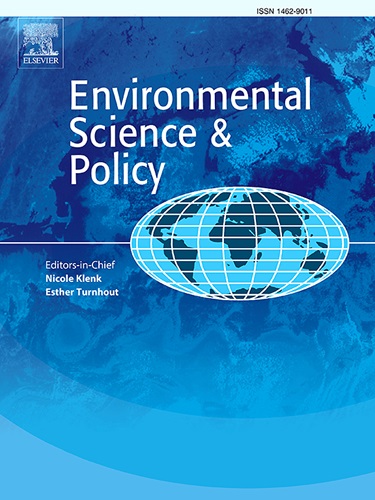From silos to synergy: Mapping institutional collaboration across global environmental science–policy interfaces
IF 5.2
2区 环境科学与生态学
Q1 ENVIRONMENTAL SCIENCES
引用次数: 0
Abstract
Science-policy interfaces (SPIs) can help address complex socio-environmental crises by providing evidence-based advice in an inclusive and collaborative manner, consistent with the co-production model. However, the growing number of inclusive SPIs in the environmental policy landscape poses challenges to the co-production model. While this issue is well-documented in other fields, there remains a limited empirical and conceptual understanding of how SPIs interact within an increasingly crowded governance landscape and the implications within the scholarly discourse on co-production. This study examines how global SPIs collaborate institutionally to address complex environmental sustainability problems, derived mainly from semi-structured interviews and survey responses with SPI stakeholders. A social network analysis revealed an extensive yet fragmented network of 41 global environmental SPI-related organizations collaborating, clustered by organization type, with many organizations disconnected as a result of low network density. Stakeholders valued collaboration across varying levels of formalization, emphasizing the potential for individual-level collaboration to enhance the effectiveness of SPIs in informing policymakers on complex issues. The study indicated how institutional collaborations were spearheaded by influential individuals and the involvement of the UN, though hindered by bureaucratic politics, power dynamics, and resource constraints. Divergent mandates, resources, and institutional cultures also shaped the feasibility and effectiveness of these collaborations. The study urges global SPIs to carefully consider both the challenges and benefits of collaboration, recommending partnerships that align with each organization's governance context and goals.
从孤岛到协同:绘制跨全球环境科学-政策界面的机构合作
科学政策接口(SPIs)可以帮助解决复杂的社会环境危机,方法是以包容和协作的方式提供基于证据的建议,符合联合制作模式。然而,环境政策领域越来越多的包容性spi对联合生产模式提出了挑战。虽然这个问题在其他领域得到了充分的记录,但对于spi如何在日益拥挤的治理环境中相互作用以及在合作生产的学术论述中的含义,仍然存在有限的经验和概念理解。本研究考察了全球SPI如何通过机构合作来解决复杂的环境可持续性问题,主要来自对SPI利益相关者的半结构化访谈和调查回应。一项社会网络分析显示,41个全球环境指数相关组织合作形成了一个广泛而分散的网络,按组织类型聚集在一起,许多组织由于网络密度低而断开。利益相关者重视在不同形式化层次上的合作,强调个人层面合作的潜力,以提高spi在向决策者通报复杂问题方面的有效性。该研究表明,尽管官僚政治、权力动态和资源限制阻碍了机构合作,但机构合作是如何由有影响力的个人和联合国的参与牵头的。不同的任务、资源和机构文化也影响了这些合作的可行性和有效性。该研究敦促全球spi仔细考虑合作的挑战和好处,建议与每个组织的治理环境和目标保持一致的伙伴关系。
本文章由计算机程序翻译,如有差异,请以英文原文为准。
求助全文
约1分钟内获得全文
求助全文
来源期刊

Environmental Science & Policy
环境科学-环境科学
CiteScore
10.90
自引率
8.30%
发文量
332
审稿时长
68 days
期刊介绍:
Environmental Science & Policy promotes communication among government, business and industry, academia, and non-governmental organisations who are instrumental in the solution of environmental problems. It also seeks to advance interdisciplinary research of policy relevance on environmental issues such as climate change, biodiversity, environmental pollution and wastes, renewable and non-renewable natural resources, sustainability, and the interactions among these issues. The journal emphasises the linkages between these environmental issues and social and economic issues such as production, transport, consumption, growth, demographic changes, well-being, and health. However, the subject coverage will not be restricted to these issues and the introduction of new dimensions will be encouraged.
 求助内容:
求助内容: 应助结果提醒方式:
应助结果提醒方式:


